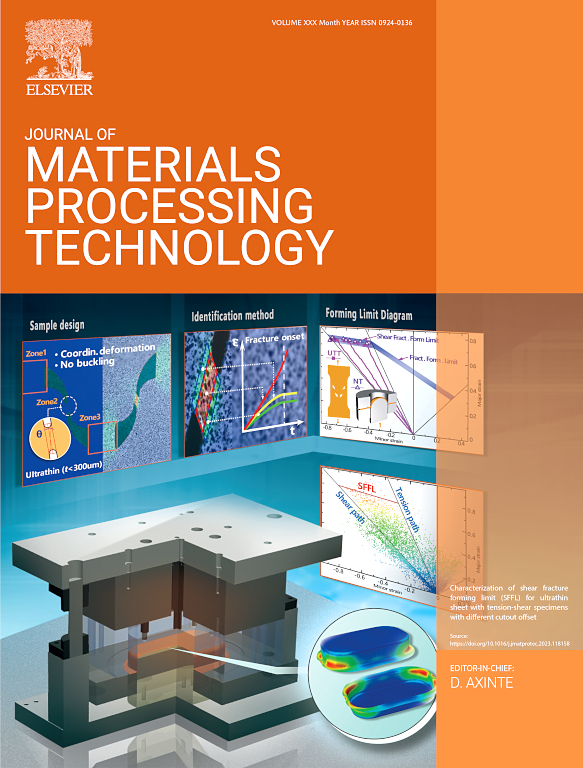The influence of slight energy density variation within the optimized parameters scope on the grain growth, precipitation behavior and mechanical property of laser direct energy deposited AA7075 alloy
IF 7.5
2区 材料科学
Q1 ENGINEERING, INDUSTRIAL
Journal of Materials Processing Technology
Pub Date : 2025-07-08
DOI:10.1016/j.jmatprotec.2025.118976
引用次数: 0
Abstract
The laser direct energy deposition (LDED) of high-strength AA7075 alloy is highly challenging owing to its inherent cracks and porosity, exhibiting narrow low-defect processing window. Meanwhile, its precipitate behavior and dislocation density, the primary source of strength, are significantly influenced by the slight variation of energy density. Therefore, this study firstly explored the operatable parameter scope for the crack-free and low-porosity fabrication of AA7075 alloy through the stepwise regulation of single-track, single-layer, and multi-layer deposition. Results indicated that the porosity was strongly related to the mass flow rate, while the pore type was more affected by energy density. Subsequently, the effects of energy densities on microstructural evolution and mechanical properties were explored among this scope. The average grain size, aspect ratio, texture intensity, and internal strain were all enhanced with the increase of energy densities, while the density of geometrically necessary dislocations peaked at 155.6 W/mm². The point-shaped coherent precipitates pinning dislocations identified as η/η' phase of MgZn2 were observed under the energy density of 155.6 W/mm², while the stripe-shaped non-coherent precipitates identified as S phase of Al2CuMg dominated under the energy density of 183.9 W/mm². The precipitation behavior models under different energy densities were then obtained through the LDED thermal history analysis. The largest ultimate tensile strength of ∼347.7 MPa occurred at 155.6 W/mm2-2 mg/mm2, which can be attributed to the joint effect of its relatively low porosity, fine grain size, high dislocation density, denser precipitation distribution and η/η' phase pinning dislocation structure. This study reveals the evolution pattern of grain growth, precipitate, and mechanical property of AA7075 alloy among the optimized parameters scope, providing a feasible solution for its in-situ microstructural regulation.
优化参数范围内能量密度的微小变化对激光直接能量沉积AA7075合金晶粒生长、析出行为和力学性能的影响
高强度AA7075合金的激光直接能量沉积(LDED)由于其固有的裂纹和孔隙,具有狭窄的低缺陷加工窗口,具有很高的挑战性。同时,其析出行为和位错密度作为强度的主要来源,受到能量密度的微小变化的显著影响。因此,本研究首先通过单轨、单层、多层的逐步调控,探索了AA7075合金无裂纹、低孔隙率制备的可操作参数范围。结果表明,孔隙率与质量流量密切相关,而孔隙类型受能量密度影响较大。随后,在此范围内探讨了能量密度对微观组织演化和力学性能的影响。平均晶粒尺寸、纵横比、织构强度和内部应变均随能量密度的增加而增大,几何必要位错密度在155.6 W/mm²处达到峰值。在155.6 W/mm²能量密度下,以MgZn2的η/η′相为钉住位错的点状共相析出;在183.9 W/mm²能量密度下,以Al2CuMg的S相为条纹状非共相为主。通过热历史分析,得到了不同能量密度下的析出行为模型。在155.6 W/mm2 ~ 2 mg/mm2时,合金的极限抗拉强度最大,达到了~ 347.7 MPa,这是相对较低的孔隙率、较细的晶粒尺寸、较高的位错密度、较致密的析出分布和η/η′相钉住型位错结构共同作用的结果。本研究揭示了优化参数范围内AA7075合金晶粒生长、析出相及力学性能的演变规律,为其原位组织调控提供了可行的解决方案。
本文章由计算机程序翻译,如有差异,请以英文原文为准。
求助全文
约1分钟内获得全文
求助全文
来源期刊

Journal of Materials Processing Technology
工程技术-材料科学:综合
CiteScore
12.60
自引率
4.80%
发文量
403
审稿时长
29 days
期刊介绍:
The Journal of Materials Processing Technology covers the processing techniques used in manufacturing components from metals and other materials. The journal aims to publish full research papers of original, significant and rigorous work and so to contribute to increased production efficiency and improved component performance.
Areas of interest to the journal include:
• Casting, forming and machining
• Additive processing and joining technologies
• The evolution of material properties under the specific conditions met in manufacturing processes
• Surface engineering when it relates specifically to a manufacturing process
• Design and behavior of equipment and tools.
 求助内容:
求助内容: 应助结果提醒方式:
应助结果提醒方式:


